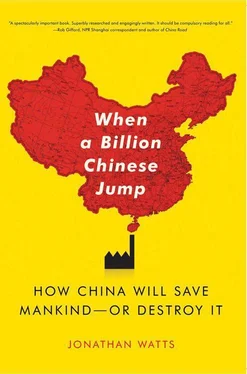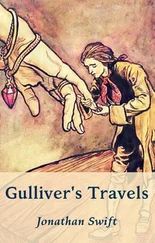As we drove away from the airport, the cause of the dark smog soon became apparent. Smoke curled up from bonfires in field after field. I asked the driver to stop and set off across a field of black stubble to talk to a local farmer, who was burning off stalks after the autumn corn harvest. After sorting the stubble into piles, he ignited the bonfire with a cigarette lighter. It burned quickly, forcing crickets and other insects to flee. The billowing smoke was a negative, inverted image of a snowstorm: a blizzard of rising black flakes. He told me that every farmer burns his field on the same day, and explained why.
This seasonal burn has been illegal for over a decade, not because it fouls the air and adds to China’s carbon emissions, but because it is a hazard to air traffic. 10But the governance problem already noted in earlier chapters is evident here too. The farmers pay no attention. Burning the stubble is the easiest and cheapest way to clear the land and put potassium into the soil. It is an environmentally expensive shortcut. If the stalks were composted and plowed back into the land, their carbon would return to the earth rather than burn into the sky. But that would be too time-consuming for modern itinerant farmers, most of whom labor in the cities and return home for just a few days to bring in the harvest. Because they all violate the regulations at once, the authorities are powerless: it would be impossible to arrest them en masse.
A short distance farther along the road I asked a policeman why he took no action. “This is rural China. This is how things are done,” he said, shrugging. “There will be a big fog tomorrow.”
Such “backward practices” are supposed to be a thing of the past. The authorities have tried to modernize Henan, but the rush to develop often caused more problems than it solved. With too many people and too few resources, the government often resorted to making money quickly by sacrificing morals, human lives, and the environment.
The last two had long been vulnerable in Henan. When the Yellow and the Huai rivers flood, this province is usually hit worst, often resulting in hundreds of thousands of deaths. During the Sino-Japanese War the Nationalist general Chiang Kai-shek considered Henan so expendable that he ordered his forces to blow up Yellow River dikes to delay Japanese troops, even though it resulted in the deaths of hundreds of thousands of people downstream and left millions homeless. Japan’s air force bombed Zhengzhou to rubble. Rebuilt, it remains one of China’s least attractive provincial capitals.
Mao Zedong warned that Henan was where rebellions started and dynasties were overthrown, but it was also where he pushed hardest to realize his belief that more people meant more power. Short of economic and military strength in the 1950s, Mao shaped his nationalist goals around the huge population. 11The founder of the republic’s credo was Renduo, Liliang Da (With Many People, Strength Is Great). In one of his more idiosyncratic metaphors, Mao compared mothers to aircraft carriers, each capable of launching up to ten fighter-plane babies. 12To Nehru in 1954, he dismissed the threat of U.S. nuclear weapons because even the world’s most powerful bomb would never be able to wipe out the massive Chinese population. From engineering to agriculture, the attitude was the same: throw enough people at a problem and it would be fixed. Little heed was paid to biological limits or natural balance. The consequences were murderous.
To demonstrate people power, Mao was drawn to Henan. During the Great Leap Forward, this was the home of the first people’s commune and the boldest agricultural experiments. 13In 1958—the year that saw the height of Maoist excess—no province went further in applying Soviet-inspired techniques of close planting and deep plowing, or in falsely claiming success. 14Doctored propaganda images of the era show wheatfields so dense that children could stand on the crop. The slogan of the age was “Learn from Henan. Catch up with Henan!” The reality two years later was a famine that killed up to 8 million people in this province alone. 15In the worst affected area of Xinyang, corpses littered the fields. 16Some desperate people resorted to cannibalism. 17In 1961, an internal party document reportedly described what happened as a “holocaust.” Officially the nationwide death toll was 14 million. Historians now estimate between 20 and 40 million people starved to death.
That was not the only way people died. The reckless pace of hydro-logical engineering of the time, mentioned in chapter 2, was particularly calamitous here. In 1958, a nationwide frenzy of dam building reached its peak in Henan, where a population of farmers was mobilized to build 110 dams in a single year. 18A decade later, more than half had collapsed, killing countless people. Others lasted longer, though with direr consequences: in 1975, the worst dam disaster in China’s history killed around 240,000 people in Henan’s Zhumadian prefecture. 19
Many of these calamities had common causes: a belief that more people meant more power, unrealistically high expectations of the land’s fertility, and regional party lackeys who took their leader’s wildest plans to absurd extremes, lied about results, then silenced any critic who dared to reveal the truth. 20After 1978, much the same could be said of the embrace of dirty industry and reckless get-rich-quick schemes that were touted as the best way to lift Henan’s huge population out of poverty.
We drove east, through the haze, across the floodplains to one of the worst-affected areas. The Huai River basin is home to 150 million people who live among its tangle of tributaries and irrigation canals. Near Henan’s border with Anhui Province, the villages here were crushed together, along with the people. Junctions were strewn with rubbish, and wider social problems were evident from a giant billboard depicting an emaciated man and a screaming entreaty: “Don’t use drugs!” More people migrated from these two provinces than almost anywhere else in China. 21It was the human pool that filled cities like Shanghai with cheap labor. There was little reason to stay. This area was often deluged by floods. In the postreform era, it had also become synonymous with pollution and sickness. 22
During the eighties and nineties, poor but venal local governments in the Huai valley were in such a rush to industrialize that they accepted and protected heavily polluting companies, such as paper mills, tanneries, and chemical plants. It was a huge risk to the health of the population, though perhaps not fully understood at the time.
Local governments did not want to miss out on the economic development that was making other parts of China rich. Environment protection officials joined “investment soliciting delegations” to promise industries that they would not face the tight controls seen in richer areas. 23Outside companies were willing to invest, to provide jobs, and—almost certainly—bribes. Many were joint ventures with multinationals that could not get approval to site their production in countries with more stringent environmental standards. Among the worst culprits was Lianhua (Lotus) Gourmet Powder Company—a joint venture between the local government and Japan’s Ajinomoto—which was China’s biggest producer of monosodium glutamate food flavoring. Every day the plant discharged 120,000 tons of wastewater. Pollution slicks of up to 70 kilometers in length were common. The Ying, a Huai tributary lauded by the Tang dynasty poet Li Bai for “crystal clear” headwaters, became a cesspool.
Almost 100 “cancer villages” have been identified in China, most of them near polluted waterways. From the mid-1990s, pioneering Chinese journalists began investigating a belt of them along the Huai River basin. Reliable information was hard to come by, locals were often intimidated, and many NGO officials and reporters were reluctant to talk on the record. Before my trip, a Chinese journalist advised me not to visit because it might put people in jeopardy. “After I published my story, my sources were constantly harassed by local public security officers. I wish I had never written the piece,” he told me.
Читать дальше










